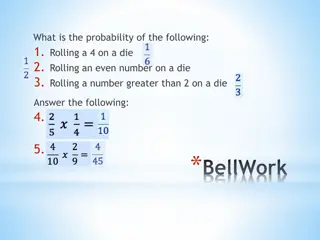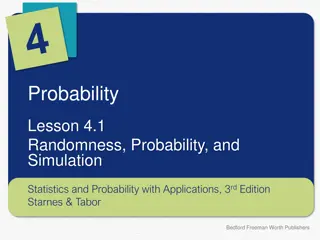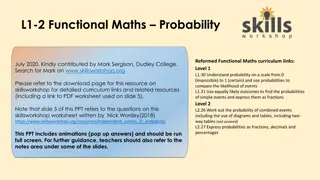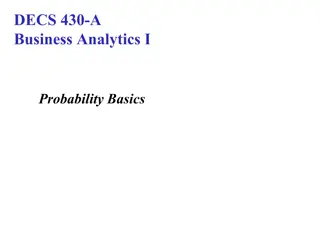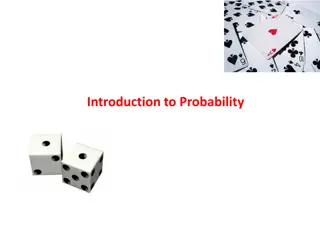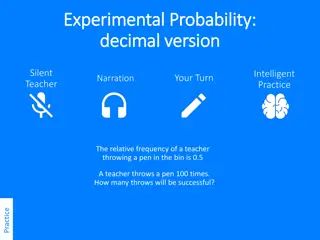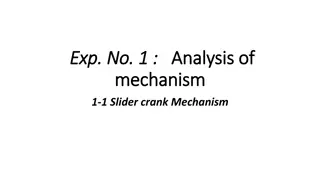Understanding Probability: Experimental and Theoretical Concepts
Probability is the measure of the likelihood of an event happening, with experimental and theoretical probability being key concepts. Experimental probability involves determining probabilities through experience or experiments, while theoretical probability can be calculated without prior experience. This article explains how to calculate both types of probabilities using examples and covers concepts such as probability space, types of probability events, and combined events.
Download Presentation

Please find below an Image/Link to download the presentation.
The content on the website is provided AS IS for your information and personal use only. It may not be sold, licensed, or shared on other websites without obtaining consent from the author. Download presentation by click this link. If you encounter any issues during the download, it is possible that the publisher has removed the file from their server.
E N D
Presentation Transcript
PROBABILITY Introduction The likelihood of an occurrence of an event or the numerical measure of chance is called probability. Types of probability Experimental probability Theoretical probability Experimental probability This is where probability is determined by experience or experiment. What is done or observed is the experiment. Each toss is called a trial and the result of a trial is the outcome. The experimental probability of a result is given by (the number of favorable outcomes) / (the total number of trials) Example 1 A boy had a fair die with faces marked 1to 6 .He threw this die up 50 times and each time he recorded the number on the top face. The result of his experiment is shown below. P(Event) =? ? ?????? ?? ????????? ???????? ? ? ????? ?????? ?? ?????? face 1 2 3 4 5 6 a ) P(1)= 11/50 Number times has shown up of 11 6 7 9 9 8 a face b) P(4)= 9/50 What is the experimental provability of getting? a) 1 b) 4
Example2 From the past records, out of the ten matches a school football team has played, it has won seven. How many possible games might the school win in thirty matches ?. Solution P(winning in one math) = 7/10. Therefore the number of possible wins in thirty matches = 7/10 x 30 = 21 matches Range of probability Measure If P(A) is the probability of an event A happening and P(A') is the probability of an event A not happening, Then P(A')= 1 - P(A) and P(A') + P(A)= 1 Probability are expressed as fractions, decimals or percentages Probability space A list of all possible outcomes is probability space or sample space .The coin is such that the head or tail have equal chances of occurring. The events head or tail are said to be equally likely or equiprobable.
Theoretical probability This can be calculated without necessarily using any past experience or doing any experiment. The probability of an event happening , P(Event) =? ? ?????? ?? ????????? ???????? ? ? ????? ?????? ?? ???????? Example1 Abasket contains 5 red balls, 4green balls and 3 blue balls. If a ball is picked at random from the basket, find: a.)The probability of picking a blue ball b.) The probability of not picking a red ball Solution a) Total number of balls is 12 The number of blue balls is 3 therefore, P (a blue ball) =3/12 b) The number of balls which are not red is 7. Therefore P ( not a red ball)= 7/12
Example2 A bag contains 6 black balls and some brown ones. If a ball is picked at random the probability that it is black is 0.25.Find the number of brown balls. Solution Let the number of balls be x Then the probability that a black ball is picked at random is 6/x Therefore 6/x = 0.25 x = 24 The total number of balls are 24 Then the number of brown balls is 24 - 6 =18 Note: When all possible outcomes are countable, they are said to be discrete.
Types of probability Events Combined Events These are probability of two or more events occurring Mutually Exclusive Events Occurrence of one excludes the occurrence of the other or the occurrence of one event depend on the occurrence of the other.. If A and B are two mutually exclusive events, then ( A or B) = P (A) + P (B). For example when a coin is tossed the result will either be a head or a tail. Example If a coin is tossed ; P(head) + P( tail) =1 2+1 2= 1 Note; If [OR] is used then we add
Independent Events Two events A and B are independent if the occurrence of A does not influence the occurrence of B and vice versa. If A and B are two independent events, the probability of them occurring together is the product of their individual probabilities .That is; P (A and B) = P (A) x P(B) Note; When we use [AND] we multiply ,this is the multiplication law of probability. Example1 Acoin is tosses twice. What is the probability of getting a tail in both tosses? Solution The outcome of the 2ndtoss is independent of the outcome of the first . Therefore; P (T and T ) = P( T) X P( T) 1 2? 1 2=1 = 4
Example 2 A boy throws fair coin and a regular tetrahedron with its four faces marked 1,2,3 and 4.Find the probability that he gets a 3 on the tetrahedron and a head on the coin. Solution These are independent events. P (H) = 1 2, P(3) =1 4 Therefore; P (H and 3) = P (H) x P (3) = x = 1/8
Example3 Abag contains 8 black balls and 5 white ones. If two balls are drawn from the bag, one at a time, find the probability of drawing a black ball and a white ball. a) Without replacement b) With replacement Solution a) There are only two ways we can get a black and a white ball: either drawing a white then a black,or drawing a black then a white.We need to find the two probabilities; 5 12=10 8 8 13? 5 12=10 39OR P(B followed by W) = P (B and W) = P( W followed by B) = P (W and B) = 13? 39 10 39=20 10 39+ The two events are mutually exclusive, therefore. = P( W followed by B ) + P ( B followed by W) = 39 b) Since we are replacing, the number of balls remains 13. Therefore; P (W and B) =5 8 13= 40 169 13? henceP [(W and B) or (B and W)] = P (W and B) + P (B and W) =40 40 169= 80 169 8 13? 5 13= 40 169 P ( B and W) = 169?
Example4 Kamau ,Njoroge and Kariuki are practicing archery .The probability of Kamau hitting the target is 2/5,that of Njoroge hitting the target is and that of Kariuki hitting the target is 3/7 ,Find the probability that in one attempt; Only one hits the target a) All three hit the target b) None of them hits the target c) Two hit the target d) At least one hits the target e) Solution a) P(only one hits the target) =P (only Kamau hits and other two miss) =2/5 x 3/4 x 4/7 = 24/140 = 6/35 P (only Njoroge hits and other two miss) = 1/4 x 3/5 x 4/7 = 3/35 P (only Kariuki hits and other two miss) = 3/7 x 3/5 x = 27/140 P (only one hits) = P (Kamau hits or Njoroge hits or Kariuki hits) = 6/35 + 3/35 +27/140 = 9/20
b) P ( all three hit) = 2/5 x 1/4 x 3/7 = 3/70 c) P ( none hits) = 3/5 x 3/4 x 4/7 = 9/35 d) P ( two hit the target ) is the probability of ; Kamau and Njoroge hit the target and Kariuki misses = 2/5 x 3/7 x 4/7 or Njoroge and Kariuki hit the target and Kamau misses = 1/4 x 3/7 x 3/5 Or Kamau and Kariuki hit the target and Njoroge misses = 2/5 x 3/7 x 3/4 Therefore P (two hit target) = (2/5 x 1/4 x 4/7) + (1/4 x 3/7 x 3/5) + (2/5 x 3/7 x 3/4) = 8/140 + 9/140 + 18/140 =
P (at least one hits the target) = 1 P ( none hits the target) = 1 9/35 = 26/35 Note; P (one hits the target) is different from P (at least one hits the target) Tree diagram Tree diagrams allows us to see all the possible outcomes of an event and calculate their probability. Each branch in a tree diagram represents a possible outcome .Atree diagram which represent a coin being tossed three times look like this; From the tree diagram, we can see that there are eight possible outcomes. To find out the probability of a particular outcome, we need to look at all the available paths (set of branches). The sum of the probabilities for any set of branches is always 1.
Also note that in a tree diagram to find a probability of an outcome we multiply along the branches and add vertically. The probability of three heads is: P (H H H) = 1/2 1/2 1/2 = 1/8 P (2 Heads and a Tail) = P (H H T) + P (H T H) + P (T H H) = 1/2 1/2 1/2 + 1/2 1/2 1/2 + 1/2 1/2 1/2 = 1/8 + 1/8 + 1/8 = 3/8 Example1 Bag A contains three red marbles and four blue marbles. Bag B contains 5 red marbles and three blue marbles. A marble is taken from each bag in turn. a) What is the probability of getting a blue marble followed by a red b) What is the probability of getting a marble of each color
Solution a) Multiply the probabilities together P( blue and red) =4/7 x 5/8 = 20/56 =5/14 b) P(blue and red or red and blue) = P( blue and red ) + P (red and blue) = 4/7 x 5/8 + 3/7 x 3/8 = 20/56 + 9/56 =29/56 ;
Example2 The probability that Omweri goes to Nakuru is .If he goes to Nakuru, the probability that he will see flamingo is .If he does not go to Nakuru, t he probability that he will see flamingo is 1/3 .Find the probability that; a) Omweri will go to Nakuru and see a flamingo. b) Omweri will not go to Nakuru yet he will see a flamingo c) Omweri will see a flamingo Solution Let N stand for going to Nakuru ,N stand for not going to Nakuru, F stand for seeing a flamingo and F stand for not seeing a flamingo.
a) P (He goes to Nakuru and sees a flamingo) = P(N and F) = P(N) X P(F) = X = 1/8 b) P( He does not go to Nakuru and yet sees a flamingo) = P (N and F) =P( N ) X P( F) = 3/4 X 1/3 = c) P ( He sees a flamingo) = P(N and F) or P ( N and F) = P (N and F) + P (N and F) = 1/8 + 1/4 = 3/8
QUESTIONS Q1 A two-digit number is formed from the first four prime numbers a) Draw the table to show the possible outcomes, if each number can be used only once b) Calculate the probability that a number chosen from the digit numbers is an even number solution a) b) P (E) = 3/12 =
Q2 The probability that a boy goes to school by bus is 1/3 and by matatu is . If he uses a bus, the probability that he is late to school is 1/5 and if he uses a matatu, the probability of being late is 3/10. If he uses other means of transport, the probability of being late is 1/20 a) Draw a probability tree diagram to represent this information b) What is the probability that he will be late for school c) What is the probability that he be late for school if he does not use a matatu d) What is the probability that he is not late for school solution
b) P(BL) or P(ML) or P(OL) (1/3 x 1/5 ) + ( x 3 /10 ) + ( 1/6 x 1/20 ) = 1/15 + 3/20 + 1/120 = 9/40 c) P(BL) or P(OL) = (1/3 x 1/5 ) + ( 1/6 x 1/20 ) = 1/15 + 1/120 = 9/40 d) 1 - P(L) = 1 - 9/40 = 31/40
Q3 A bag contains 10balls of which 3 are red, 5 are white and 2 are green. Another bag contains 12balls of which 4 are red, 3 are white and 5 are green. A bag is chosen at random and then a ball chosen at random from the bag. Find the probability that the ball so chosen is red solution = P(AR) or P(BR) = ( x 3/10 ) + ( x 4/12) = 3/20 + 1/6 = 19/60
Q4 Students who performed well in an examination are to be given an outing. A student has to throw two dice. If he gets a sum greater than 8, he gets a two-days outing, otherwise he gets a one-day outing. a) Find the probability that a student gets a two-day outing b) A student who qualifies for a two-day outing throws a die and a coin to decide whether he gets pocket money for the two days or for only one day. If he gets a head and a multiple of 3 he gets pocket money for two days. Find the probability that he is given a two-day outing but given pocket money for only one day c) If a student gets a one-day outing, he throws a die to decide if he gets pocket money or not. If he gets a number greater than 4 he gets the pocket money. Find the probability that: i) A student gets pocket money for two days ii) A student gets pocket money
Solution a) = P (2 days out) = P ( sum > 8) = 10/36 = 5/18 b) P (2 days out and 1 day pocket money) = 5/18 x 10/ 12 = 25/108 c) I i) P (2 days out and 2D pocket) = 5/18 x 2/12 = 5/108 ii) P (2 D and 2D pocket) or P (2 D and 1D pocket) or P (1 D and pocket) = (5/18 x 2/12) + (5/18 x 10/12) + (13/18 x 2/6) = 5/108 + 25/105 +13/54 = 14/27
Q5 The ages in years of five boys are 7, 8, 9, 10 and 11 while those of five girls are 4, 5, 6, 7 and 8. A boy and a girl are picked at random and the sum of their ages is recorded. (a) Draw a probability space to show all the possible outcomes. (b) Find the probability that the sum of their ages is at least 17 years. Solution
END REMEMBER TO SUBSCRIBE





